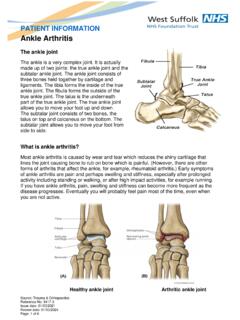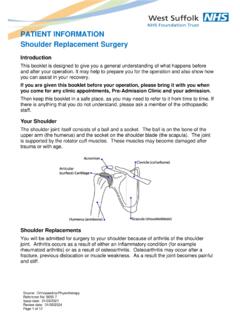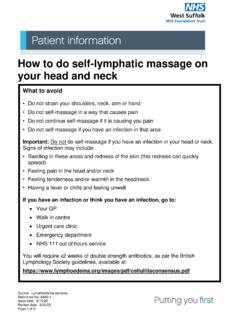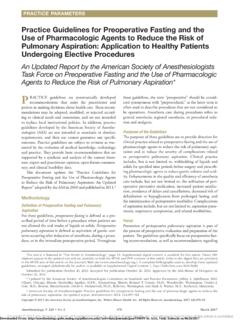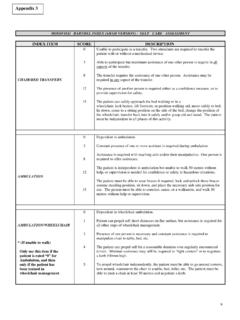Transcription of Urinary Tract Infections Recurrent Infections
1 This booklet is designed to help women understand more about Urinary incontinence and the choices available. Please keep it and take it with you to your appointments. Recurrent urinarytract infectionsA collaborative process that allows patients and their providers to make health care treatment decisions together, taking into account the best scientific evidence available, as well as the patient s values and by NHS West Suffolk Clinical Commissioning Group and West Suffolk NHS Foundation Trust2 ContentsSection 1 What is a Urinary Tract infection? 3 Why do women get Urinary Tract Infections ? 4 How do I try to avoid a Urinary Tract infection?
2 5 Behaviours to consider to help avoid a Urinary Tract infection 6 What to do if I think I have a Urinary Tract infection 7 Section 2 Self help 8 What to do if the symptoms are not going away 8 Recurrent Urinary Tract Infections 9 Investigations 9 Section 3 Recurrent Urinary Tract Infections in all age groups 10 Recurrent Urinary Tract Infections in older women 12 Urinary Tract Infections in pregnancy 13Is your treatment of your Recurrent Urinary Tract infection helping? 14 Section 4 Coming to hospital 16 Hospital based treatments 17 Surgery 17 Section 5 Your notes 18 IntroductionInfections affecting the Urinary Tract are very common; affecting most women at least once in their lifetime, but up to one in five women will have problems with repeated Infections .
3 They are most likely in women who are sexually active, pregnant or post-menopausal (gone through their change ) but they can happen at other Urinary Tract infection (UTI) is the invasion of your Urinary Tract (urethra, bladder and kidneys) with bacteria, which then causes you symptoms. Your symptoms will depend on the part of the Urinary Tract involved. For the purposes of this booklet we will be considering Infections in the bladder, commonly called cystitis . The cystitis symptoms you may experience with a UTI may include: A need to frequently pass urine An inability to hold your urine with a feeling of needing to pass your urine urgently A feeling of burning or stinging in the water pipe (urethra) on passing urine or pain at the end of passing urine.
4 Sometimes you may also notice that your urine becomes cloudy, smelly or even stained with blood. If you have a mild infection, it can often clear within a few days and may not always need antibiotics. More severe Infections will probably require treatment. The good news is that there are lots of things which you, your pharmacist, practice nurse or doctor can do to help you manage your Recurrent cystitis. However, if you experience blood in your urine without any other symptoms, please make sure you talk to your GP urgently so they can arrange to investigate it. What is a Urinary Tract infection? 4 Why do women get Urinary Tract Infections ?
5 In women, there is only a short distance between the water pipe (urethra) and the back passage (anus).The most common bacteria that cause UTI are E. coli. These bacteria ordinarily live inside our colon and are essential to keeping the colon bacteria from the colon are often spread when people open their bowels and because the water pipe is so close then this can lead to the bacteria gaining access to the Urinary Tract . The body has its own defence mechanism to try and stop this happening - vaginal secretions. These secretions are rich in healthy bacteria that help to stop these colonic from reaching the water pipe.
6 Common things like sexual intercourse, constipation and Urinary or bowel incontinence can increase the risk of UTI by either disrupting the vaginal secretions/bacteria or by allowing overgrowth of the healthy bacteria with colonic bacteria. Other things like soaps, wet wipes etc. can cause inflammation of the delicate genital skin and wash away vaginal secretions, and thus can also increase the risk of a UTI. Often Recurrent UTI can run in families and it is thought that there is a genetic reason for this with a mildly altered constitution of the urine making you more susceptible to Womb(uterus)Cervix5 How do I try to avoid a Urinary Tract infection?
7 One of the most effective things you can do to help prevent cycles of Recurrent infection is to make some simple changes to your lifestyle. These include: Wiping front to back : After going to the toilet it is important to push the toilet paper from the front, near your water pipe, towards your bottom. If you pull the paper from near your bottom towards your water pipe you can transfer bacteria closer to the water pipe, making it easier for them to cause an infection. Drink plenty of fluids: Many people just don t drink enough water or fluid. If urine is dark yellow or brown in colour it is showing you that you are dehydrated.
8 If you do not drink plenty then people often do not pass urine frequently. This means the bladder stores urine for a longer time between emptying and so can act as reservoir of bacteria. You should try to drink enough fluid to keep your urine pale yellow or even clear. The lowest amount/day should be litres of fluid but you should aim to drink 2 litres per day, unless you have been advised otherwise. Avoid soaps, shower gels and intimate hygiene products: Washing with soap or other products removes this natural protection of the vaginal secretions and can even cause chemical irritation, which promotes infection.
9 Limit washing the vaginal area to once a day: Ladies with UTI often believe the infection comes as they are not clean enough and so try to improve hygiene in the vaginal area by washing more than once a day. This practice, unfortunately, has the opposite effect as it washes the healthy vaginal secretions away. Sexual hygiene: Many women experience honeymoon cystitis or UTIs, which occur after having intercourse. Passing water and washing gently with warm water after sex can help reduce the amount of bacteria present which may cause infection. Constipation: Avoid constipation with a diet full of fibre and a healthy intake of fluid.
10 If this is a continuing problem then this may be something you wish to discuss with you GP or nurse. Incontinence: Treating incontinence, whether Urinary or faecal, can help reduce the risk of UTI, so if you are suffering with these symptoms please discuss this with your GP or practice LISTP lease consider the following behaviours to help avoid contracting a Urinary Tract infection. 1. Wiping front to back Yes No 2. Keep urine pale yellow or clear by drinking plenty of fluid Yes No 3. Avoid intimate soaps, gels or wipes Yes No 4. Only wash the vaginal area once a day Yes No 5.

